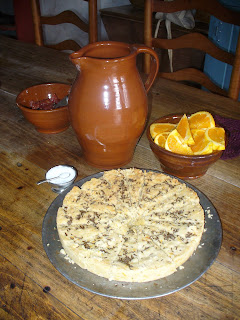In 1692 and 1693, witches were considered to be a very real and scary danger in the Puritan colony of Massachusetts. It was thought that witches were the cause of many sicknesses, ills and misfortunes in a time when many illnesses were misunderstood.
Fear of witches, witchcraft and being possessed by demons was very real and eventually created mass hysteria in Massachusetts towns like Salem.
Witches in the 1600s were scarier than "pointy hat witches" are depicted today; witches typically looked normal--so it was hard to know who was a witch which led to people mistrusting their friends and neighbors. Anyone slightly abnormal, including foreigners was a candidate for witchcraft. During the Salem Witch Trials, devout Christians of high social standings were being accused of being possessed by demons which was unprecedented.
Prior to the trials it was believed that the demons could not possess those who were devoted to Christianity. This lead to a belief that the devil was getting more powerful and that no one was safe.There was a general belief that witches flew, naked on broomsticks to "witches' assemblies" or "Devil Sabbats" which were held deep in the forest and many people at the time thought they saw their neighbors flying away to them.
Cotton Mather was a reverend and trusted writer on witchcraft and it is thought that his sermons and writings on witches helped ignite the witch hysteria during the late 1600s. Although after the trials he claimed that people could not be convicted of "
spectral evidence" alone, many people were convicted one solely the claims of others.
Cotton Mather Approved These Ways of Identifying Witches:
- "If the Party
suspected be found to have the Devil's mark ; for it is commonly thought,
when the Devil makes his Covenant with them, he alwaies leaves his mark
behind them, whereby he knows them for his own:—a mark whereof no
evident Reason in Nature can be given."
- Birthmarks, moles, and
other skin abnormalities were considered proof of a witch. A confession
and a mole were sufficient evidence to condemn a person to death. People
believed that these unexplainable marks were made when the devil touched
his followers in order to be able to recognize them. These marks were
sometimes referred to as "witches’ teats" and it was thought
that witches fed evil creatures with them. (How many people have a skin abnormality?)
- "If
it can be proved, that the party hath entertained a Familiar Spirit, and
had Conference with it, in the likeness of some visible Creatures ; here
is Evidence of witchcraft."
- Some black cats, toads, humanoid figures, spirits,
certain dogs were thought to be "familiar friends" of witches.
These familiars were thought to help witches carry out their curses and
spell casting. Some people even thought that witches could even turn into
a cat 9 times during their lifetime, creating the folklore that
"cats have 9 lives." Witches were expected to feed their
familiars, this could be done through their "devil's mark," or
not. (How many people feed stray cats?)
- “By the Witches Words
As when they have been heard calling on speaking to or Talking of their
Familiars or when they have been heard Telling of Hurt they have done to
man or beast Or when they have been heard Threatning of such Hurt Or if
they have been heard Relating their Transportations.”
- (How many people talk
to their animals?)
- “By the Witches
Deeds. As when they have been seen with their Spirits, or seen secretly
Feeding any of their Imps. Or, when there can be found their Pictures,
Poppets, and other Hellish Compositions.”
- (How many people own a
scary doll?)
- “By one or more
Fellow- Witches, Confessing their own Witchcraft, and bearing Witness
against others; if they can make good the Truth of their Witness, and give
sufficient proof of it.”
- Sufficient proof could be as simple as having a
respected church member claim that they had seen the witch in question do
something witch-like. (How many people have angered another human
being enough that they would pretend that you are evil?)
- “By the Witches own Confession,
of Giving their Souls to ' the Devil. It is no Rare thing, for Witches
to Confess.”
- It was thought that the devil walked the forests with
a book where he would collect the names of people who would sign their souls
over to him. Many people did confess to being witches. It is thought that many
people admitted to being witches in a hope to end their ordeal.
Cotton Mather,
Wonders of the Invisible World (London: John Russell Smith, 1862), 30-32.
So how many of you would have been Puritan Witch Candidates? It seems silly now but when you read the writings during the time about witches, you can truly sense the fear that there was. I honestly admit that it scares me to read the
Wonders of the Invisible World at night. :D There are passages that allude that those who killed all of those "witches" did their duty and if they had been witches themselves they would expect their neighbors to kill them for the sake of their colony. Hysteria is fascinating as is how powerful fear can be.
I always wonder about the Puritan naming system, I thought "Cotton" was a strange name but then his father was named "Increase,"and a 5 year old "witch" was named "Dorcas Good," (she claimed that a little snake would suckle blood from her finger."





